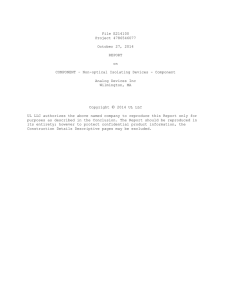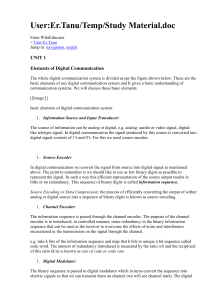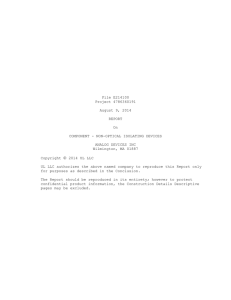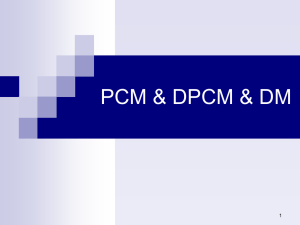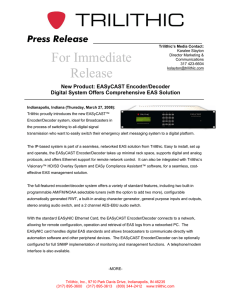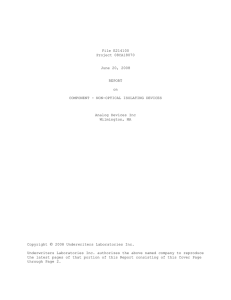Causal transmission of colored source frames over a packet erasure channel
advertisement
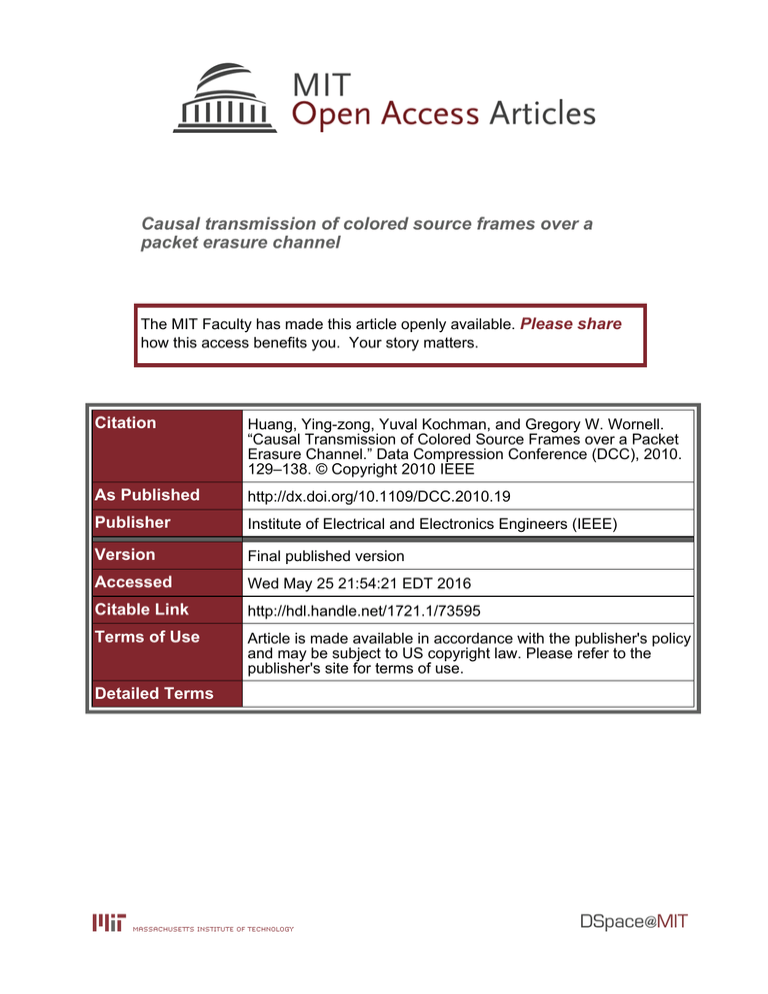
Causal transmission of colored source frames over a
packet erasure channel
The MIT Faculty has made this article openly available. Please share
how this access benefits you. Your story matters.
Citation
Huang, Ying-zong, Yuval Kochman, and Gregory W. Wornell.
“Causal Transmission of Colored Source Frames over a Packet
Erasure Channel.” Data Compression Conference (DCC), 2010.
129–138. © Copyright 2010 IEEE
As Published
http://dx.doi.org/10.1109/DCC.2010.19
Publisher
Institute of Electrical and Electronics Engineers (IEEE)
Version
Final published version
Accessed
Wed May 25 21:54:21 EDT 2016
Citable Link
http://hdl.handle.net/1721.1/73595
Terms of Use
Article is made available in accordance with the publisher's policy
and may be subject to US copyright law. Please refer to the
publisher's site for terms of use.
Detailed Terms
2010 Data Compression Conference
Causal transmission of colored source frames
over a packet erasure channel
Ying-zong Huang, Yuval Kochman & Gregory W. Wornell
Dept. of Electrical Engineering and Computer Science
Massachusetts Institute of Technology
Cambridge, MA 02139
{zong,yuvalko,gww}@mit.edu
Abstract
We propose a linear predictive quantization system for causally transmitting parallel sources with temporal memory (colored frames) over an erasure channel. By
optimizing within this structure, we derive an achievability result in the high-rate limit
and compare it to an upper bound on performance. The proposed system subsumes the
well-known PCM and DPCM systems as special cases. While typically DPCM performs well without erasures and PCM suffers less with many erasures, we show that
the proposed solution improves performance over both under all severities of erasures,
with unbounded improvement in some cases.
1 Introduction
The coding and transmission of colored sources under a variety of constraints is a problem
of practical interest. The linear predictive structure as exemplified by DPCM has long
been favored in solutions to this problem as an intuitive and low-complexity way to exploit
source memory.
Classically, scalar DPCM was used for audio and scanline image and video coding,
due to its lower bit rate relative to, e.g., PCM while still allowing sequential processing. In
recent years, inspired by the structure of interframe motion prediction in video coders, there
has been renewed interest in the vector DPCM structure for which optimality as measured
against fundamental bounds was proved in several settings. In [1], it is shown that for
stationary Gaussian sources, the Gaussian rate-distortion bound is achievable at all rates by
vector-quantized DPCM if non-causal pre- and post-filtering is allowed. Furthermore, an
analysis contained in [2], if carried to the stationary setting, shows that for Gauss-Markov
sources, DPCM with causal MMSE estimation is optimal among all causal systems.
In this paper, we take a line of inquiry similar to [2], but also consider channel erasures.
In applications such as real-time internet video conferencing, it is more realistic to assume
This work was supported in part by Hewlett-Packard under the MIT/HP Alliance, and by a grant from
Microsoft Research.
1068-0314/10 $26.00 © 2010 IEEE
DOI 10.1109/DCC.2010.19
129
that both a causality constraint on coding and errors during transmission are present. The
combination is particularly interesting because causality severely limits what can be done
about the errors, e.g., channel coding is impossible. Although in this paper we do not find
what the generally optimal coding system is for this set of constraints, we do determine
what is optimal among linear predictive structures under a few assumptions. The linear
predictive structure is chosen as a productive starting template for several reasons: (1) it
was recognized very early that adverse effects of channel errors were reducible by altering
predictors in DPCM [3, 4]; and (2) engineering practice in, e.g., video coding shows that
good prediction (interframe coding) can be traded for robustness against errors (intraframe
coding) within an overall predictive coding framework. However, let us note that while the
work is motivated by practical applications, the solution is a mathematical demonstration
of concept, albeit one that can still be a suggestive guide for designers.
After we formulate the problem more precisely in Section 2, we consider as a solution
the linear predictive quantization system that generalizes both DPCM and PCM in Section
3, where we also show its behavior on simple sources. We optimize performance for general stationary Gaussian sources in the high-rate limit in Section 4, and give closed-form
solutions for performance comparisons.
2 Problem formulation
The practical scenario we model is the following. Frames of data indexed by time are
given to the encoder to be immediately encoded (e.g., quantized) at some fixed rate and
then transmitted as packets across a link that erases packets at certain times. A decoder
receives either the correct packet or knows the packet is erased, and immediately decodes
and renders a reproduction frame, possibly aided by intelligent concealment making up for
any missing data. We look for the encoder and decoder pair that optimizes the source-toreproduction MSE distortion in the system. Our model for the problem follows.
2.1 Source model
Let {s[t]}t = {(s1 [t], ..., sN [t])}t be a vector of N parallel source sequences, which can be
viewed as a sequence of frames. In our notation, motivated by the video coding application,
the bracketed index t is the temporal dimension and the N vector components make up the
(typically very large) spatial dimension. We assume the source is:
1. Spatially i.i.d.: For all t, {si [t]}t is independent of {sj [t]}t whenever i 6= j, and
they have the same distribution. We omit the spatial index i when referring to a
representative scalar sequence {si [t]}t should there be no ambiguity.
2. Temporally autoregressive: P
Each scalar stream {s[t]}t is stationary AR(P ), characterized by s[t] = z[t] + Pp=1 αp s[t − p], with white innovation process z[t] ∼
P
N (0, Σz ), and α1 , ..., αP such that all roots of 1 − Pp=1 αp z −p satisfy |z| < 1.
Denote by Φs (f ) = Σz / |1 − A(f )|2 the power spectral density of s[t], where A(f ) =
´1
PP
−j2πf p
. The source variance is Σs = −2 1 Φs (f )df . The distortion-rate function
p=1 αp e
2
130
Ds (R) of the scalar process {s[t]}t at sufficiently high rates (R ≥
where the Shannon Lower Bound is tight) is,
1
2
log supf |1 − A(f )|2 ,
Ds (R) = Σz 2−2R ,
(1)
which equals the distortion-rate of the innovation process {z[t]}t (cf. [5], p. 233).
In the rest of this paper we always normalize Σz = 1, so that the P parameters α1 , ..., αP
(equivalently, A(f )) entirely characterize the source.
2.2 Channel model
At each time t, the channel C(·) is capable of transmitting a packet of ⌈N R⌉ bits. The channel has two states. The channel state is an i.i.d. process described by an erasure probability
ǫ. In the no-erasure state occuring with probability 1 − ǫ, the input is reproduced exactly
at the output. In the erasure state occuring with probability ǫ, the output is a special lost
packet symbol ∅ immediately recognizable by the decoder, but there is no feedback to the
encoder.
2.3 Encoder and decoder models
At time t, the causal encoder takes current and past source vectors s[t], s[t − 1], ... as input
and produces a packet Et = ENC(s[t], s[t − 1], ...) of ⌈N R⌉ bits. The causal decoder takes
current and past receptions C(E t ), C(Et−1 ), ... and produces ŝ[t] = DEC(C(Et ), C(Et−1 ), ...),
a reproduction of the newest source vector s[t].
2.4 Performance and objective
The average distortion per scalar sample between source s[t] and its reproduction
PNŝ[t] at
1
time t is the MSE distortion averaged over the spatial dimension: d(s[t], ŝ[t]) = N i=1 (si [t]−
ŝi [t])2 . Define the time-averaged expected distortion to be:
T
1X
D(R; ǫ) , lim
E {d(s[t], ŝ[t])} ,
T →∞ T
t=1
where expectation is taken over all source and channel realizations. The objective of the
problem is to minimize the excess distortion ratio
L(R; ǫ) , D(R; ǫ)/Ds (R),
for the supplied R and ǫ and Ds (R) as in (1) , by designing the encoder and decoder. We
see later that when looking at the high-rate limit, it is more insightful to let R grow and ǫ
shrink such that λ , ǫ/2−2R is a fixed constant. In that case, the figure of merit becomes
L∞ (λ) , lim L(R; λ2−2R ) = lim D(R; λ2−2R )/2−2R ,
R→∞
R→∞
(0 < λ < ∞).
(2)
3 Preliminary insights
As discussed in Section 1, we consider the problem within the class of linear predictive
quantization systems for reasons of tractability and the importance that such systems play
in engineering practice.
131
x̂[t]
s[t]
+
x[t]
–
Q
Channel
x̂′ [t]
ŝ′ [t]
+
Encoder
+
K
k=1 βk z
−k
+
+
Predictor
Decoder
L
l=1
ŝ[t]
γl z −l
Predictor
Figure 1: A causal, linear predictive quantization system model. Q is a quantizer coding the N -vector x[t].
3.1 Linear predictive quantization system
While more general structures are possible, Fig. 1 shows the linear predictive encoder and
decoder structure we consider in this paper.
Since erasures occur at the packet level, we suppress details relating to bitstream encoding and decoding for the channel. With that abridgement, x̂′ [t] and x̂[t] are respectively
the channel input and output of the system, with x̂[t] = x̂′ [t] when there is no erasure and
x̂[t] = ∅ otherwise.
P
′
The quantizer Q takes the differential signal x[t] = s[t] − K
k=1 βk ŝ [t − k] as input
and produces as output x̂′ [t] ∈ X̂t ⊆ RN at rate R per scalar sample (H(x̂′ [t])/N =
R). We model Q as a “forward” AWGN channel x̂′ [t] = x[t] + q[t], where q[t] is the
quantization error, independent of x[t]. This is a common abstraction and is realized via
entropy-constrained dithered quantization (ECDQ). 1
As required by the problem formulation, the encoder and decoder incur no delay, but
both are allowed to access their entire causal history and adapt to inputs. The encoder’s
source-tracking signal ŝ′ [t] is produced by the encoder’s K-th orderPcausal linear predictor
′
operating on the encoder’s past reconstructions: ŝ′ [t] = x̂′ [t] + K
k=1 βk ŝ [t − k]. The
decoder uses an
PLL-th order causal linear predictor to reconstruct the current sample ŝ[t]:
ŝ[t] = x̂[t] + l=1 γl ŝ[t − l]. Note that a “standard” (fully predictive) DPCM system for
the AR(P ) source uses the P -th order filter, with tap weights α1 , ..., αP equal to the source
parameters, in both the encoder and decoder predictors. Alternatively, placing all-zero
filters in the encoder and decoder predictors makes the system equivalent to standard PCM
with no prediction. Therefore, the system here subsumes both DPCM and PCM and admits
a type of continuous hybridization between full-prediction and no-prediction systems.
The following standard “DPCM identity” [3] holds:
ŝ′ [t] − s[t] = x̂′ [t] − x[t] = q[t].
(3)
In the following sections, we are interested in the regime of the combination of the
following limits:
1. Large spatial dimension: N → ∞. This allows the notational convenience of analyzing the scalar version of the problem, while still letting the quantizer Q achieve
1
Additional gain factors make Q an optimal quantizer for general rates, but they are not needed in highrate results. See [1] for examples and further references.
132
vector quantization performance if it codes a large number of independent samples.
If x[t] is zero-mean Gaussian with variance Σx , the quantization error has variance
Σq = Σx /(22R − 1)
(4)
in the limit. In practice, at finite N , we can replace Σx by a slightly larger term, where
the maximal loss even for scalar transmission is the equivalent of 12 log( 2πe
) ≈ 0.25
12
bits per scalar sample.
2. Sparse erasures: ŝ′ [tǫ − 1] = ŝ[tǫ − 1] before an erasure at tǫ . This allows analyzing
each erasure separately as their distortion effects interact additively. This happens
when erasures occur far apart compared to system memory.
3. High rate: R → ∞. Consequently, Σq ≪ Σz ≤ Σs , and Q as described becomes an
optimal quantizer.
3.2 One-tap prediction for AR(1) Gaussian sources
We defer the main results on general sources to Section 4. In this section, we show how
one-tap DPCM and PCM perform without and with erasures for an AR(1) Gaussian source
s[t]. We then propose to achieve better performance by using one-tap “leaky prediction,”
introduced here not as a novel scheme but to give intuition for the main results.
3.2.1
One-tap DPCM and PCM
Under standard DPCM, the predictors “match” the source and only use one tap of weight,
γ1 = β1 = α1 . Under standard PCM, γ1 = β1 = 0. Without erasures, the distortion is
from the quantization error q[t], and is governed by the input variance Σx , as in (4). The
zero-erasure distortions are:
Σz + α12 Σq
1
= 2R
2R
2 −1
2 − 1 − α12
1
Σs
=
DPCM (R; 0) = 2R
2
2 −1
(1 − α1 )(22R − 1)
DDPCM (R; 0) =
If erasures occur, the choice of decoder for a given encoder is less obvious. We can let
x̂[tǫ ] = 0 whenever the packet at tǫ is erased, in which case the encoder-decoder asynchrony
replaces the quantization error q[tǫ ] by an error equal to −x[tǫ ], which filters through the
decoder predictor loop as error propagation for t ≥ tǫ .
Under DPCM (still with γ1 = β1 = α1 ), the distortion is
1 − 3α12
1
−
DDPCM (R; 0) .
(5)
DDPCM (R; ǫ) = DDPCM (R; 0) + ǫ
1 − α12
1 − α12
Under PCM, for the sample at tǫ , the decoder can do significantly better by switching from
the standard decoder (γ1 = β1 = 0) to the DPCM decoder (γ1 = α1 ). When we refer to
PCM throughout the remainder of the paper where erasures occur, we will always mean
PCM with this decoder modification during erasures. Therefore,
DPCM (R; ǫ) = DPCM (R; 0) + ǫ 1 − (1 − α12 )DPCM (R; 0) .
(6)
133
In the high-rate limit, the performances in terms of excess distortion ratio [cf. (2)]
corresponding to (5) and (6) respectively become:
L∞
DPCM (λ) = 1 + λΣs = 1 +
L∞
PCM (λ) = Σs + λ =
λ
1 − α12
1
+λ
1 − α12
(7)
(8)
As anticipated, there is a critical error threshold, λ = 1, such that L∞
DPCM (λ) <
∞
∞
∞
LPCM (λ) if λ < 1 but LDPCM (λ) > LPCM (λ) if λ > 1.
3.2.2
One-tap leaky prediction
The fact that neither PCM nor DPCM dominates over all error severities suggests that an
intermediate encoder predictor, coupled with a suitable decoder predictor, can improve
performance over both schemes. A reasonable possibility we consider in this section is
to optimize over all one-tap predictors β1 between the extremes of DPCM (β1 = α1 ) and
PCM (β1 = 0). The resulting system is sometimes termed “leaky prediction” [6]. As in
the previous section, we use a decoder matched to the encoder predictor (γ1 = β1 ) when
there are no erasures, and a DPCM predictor (γ1 = α1 ) with x̂[tǫ ] = 0 whenever there is an
erasure at time tǫ . 2
Without erasures, the distortion is again governed by Σx through (4). With x[t] =
(α1 − β1 )s[t − 1] − β1 q[t − 1] + z[t], and the summands being mutually independent, the
distortion amounts to:
(α1 − β1 )2
Dleaky (R; 0) = 1 +
(22R − 1 − β12 )−1 .
1 − α12
When there is an erasure at time tǫ , the encoder-decoder asynchrony propagates error
for t ≥ tǫ , and replaces the erasure-free identity ŝ[t] − s[t] = q[t] by ŝ[t] − s[t] = q[t] −
β (t−tǫ ) (z[tǫ ] − α1 q[tǫ − 1] + q[tǫ ]). Taking these errors into account, the distortion is
1
1 − α12 − 2β12
Dleaky (R; ǫ) = Dleaky (R; 0) + ǫ
−
Dleaky (R; 0) .
(9)
1 − β12
1 − β2
Fig. 2 shows that the optimal amount of prediction “leakage,” as captured by β1 = β ∗ ,
shifts from better prediction (DPCM, β ∗ → α1 ) to better error resilience (PCM, β ∗ → 0)
as the error severity ǫ increases.
In the high-rate limit, the excess distortion ratio [cf. (2)] corresponding to (9) is
(α1 − β1 )2
λ
∞
Lleaky (λ) = 1 +
+
.
(10)
2
1 − α1
1 − β12
The three expressions (7), (8), and (10) all show distortion composed of two terms, the
first being distortion caused by quantization, and the second, distortion caused by channel
erasures. In DPCM, the first term is smaller than in PCM, at the expense of the second being
larger, while in leaky prediction, the encoder predictor β1 optimally adjusts the relative
weights of the two terms for a given λ. Fig. 3 shows leaky prediction outperforming both
DPCM and PCM.
2
Or, as an alternative interpretation, we use the erasure-free decoder at an erased sample, but “simulate”
the missing decoder input as x̂[tǫ ] = (α1 − β1 )ŝ[tǫ − 1].
134
1
12
0.8
L∞(λ) (dB)
10
β*
0.6
0.4
DPCM
PCM
leaky prediction
8
6
4
0.2
2
0
0
0.02
0.04
0.06
0.08
0
−1
0.1
ε
Figure 2: Encoder predictor β1 = β ∗ that minimizes
Dleaky (R; ǫ) for R = 3 bits/sample and various values
of α1 = {0, 0.1, 0.2, ..., 0.9} (bottom to top).
−0.5
0
log λ
0.5
1
Figure 3: DPCM, PCM, and one-tap leaky prediction
performance compared for an AR(1) source with α1 =
0.7, R = 3. The critical error threshold is at λ = 1.
4 Main results
The previous section shows that for AR(1) sources, one-tap leaky prediction performs better than DPCM and PCM. As we will see shortly, one-tap predictors are not optimal for
AR(1) sources when there are erasures, even in the high-rate limit. In this section, we derive optimized predictors for the linear predictive quantization system for colored Gaussian
sources in the high-rate limit.
In order to be able to evaluate the systems we develop more meaningfully, we first
develop a simple lower bound on the distortion achievable by any causal system.
4.1 Performance bound
As before, Ds (R) is the distortion-rate function of the source s[t]. D∆ (R) is the expected
additional distortion caused by each erasure under some particular scheme, and Dǫ is the
expected distortion on just the erased sample. The distortion can be lower-bounded as:
D(R; ǫ) = (1 − ǫ)D(R; 0) + ǫD(R; 0) + ǫD∆ (R)
≥ (1 − ǫ)Ds (R) + ǫDǫ
≥ (1 − ǫ)2−2R + ǫ
D(R; 0) ≥ Ds (R) by the definition of the distortion-rate function. D(R; 0) + D∆ (R) is the
total distortion on an erasure at some time tǫ , plus additional distortion thereafter. This is
greater than the distortion at tǫ only, which is in turn lower-bounded by the error variance
of optimal prediction of s[tǫ ] from its entire causal past s[tǫ − 1], s[tǫ − 2], .... This is simply
the variance of the innovation process (Σz = 1).
Consequently, in the high-rate limit, the excess distortion ratio [cf. (2)] satisfies
L∞ (λ) ≥ 1 + λ.
135
(11)
11
DPCM
PCM
optimized
bound
10
L∞(λ) (dB)
9
8
7
6
5
4
1
2
3
4
5
6
7
spectral variation parameter u
8
9
10
Figure 4: Performance comparison (λ = 2) between three systems and the bound of (11) as a function of the
spectral variation parameter u, for the source with discontinuous spectrum of Example 3. The performance
gaps from either DPCM or PCM to the system with optimized parameters are unbounded when u is taken
arbitrarily large.
4.2 Achievable performance for colored sources at high rate
We have the next result on the performance achievable by schemes of the form of Fig. 1.
Theorem 1. Let s[t] be a stationary Gaussian source with power spectral density Φs (f )
´1
and unit entropy power, i.e., Ns = exp −2 1 log Φs (f )df = 1. The excess distortion ra2
tio [cf. (2)]
(ˆ 1
)
ˆ 1
2 Φ (f )
2
s
L∞ (λ) = min
df + λ
Φv (f )df
(12)
Φv (f ):Nv =1
− 12 Φv (f )
− 21
is achievable, where Φv (f ) is any valid power spectrum and Nv is its entropy power.
We call the minimizing Φ∗v (f ) the spectrum of a virtual source. The optimal encoder
predictor to achieve this L∞ (λ) is the DPCM predictor for this virtual source, rather than for
the actual source s[t]. We will also see that this encoder predictor is a spectral compromise
between the DPCM predictor and PCM predictor for s[t].
p
It is easily verified that L∞ (λ = 1) is achieved by Φ∗v (f ) = Φs (f ).
Example p
2. Applying the λ = 1 case to an AR(1) Gaussian source, the virtual source
spectrum Φs (f ) = 1/ 1 − α1 e−j2πf is clearly not AR(1). Thus, the possibility of a
one-tap optimal encoder predictor for s[t] is precluded.
Example 3. Applying the result beyond finite-order AR(P ) sources, let s[t] be a colored
Gaussian source with a two-level spectrum: Φs (f ) = u > 0 for |f | ≤ 1/4 and Φs (f ) = u−1
for 1/4 < |f | ≤ 1/2. (Note that with this parameterization, Ns = 1 for all u > 0.)
The optimal virtual source spectrum will also be two-level, i.e., Φ∗v (f ) = v ∗ for |f | ≤
1/4 and Φ∗v (f ) = v ∗−1 for 1/4 < |f | ≤ 1/2. The p
minimization (12) then amounts to
∗
∞
−1
min
p v>0 u/v + v/u + λv + λ/v. Solving gives v = (λ + u)/(λ + u ) and L (λ) =
(λ + u)(λ + u−1 ).
136
x̂[t]
+
ŝ[t]
+
B(f )
ẑ[t]
+
A(f )
–
+
ŝ[t]
+
A(f )
Figure 5: The equivalent system at the decoder. When a sample is not erased, the entire decoder implements
1/(1 − B(f )). When a sample is erased, the first two filters are effectively bypassed as the decoder sets ẑ[t]
to 0.
−1
Compare with L∞
+ u−1 ) /2 and L∞
DPCM (λ) = 1 + λ (u√
PCM (λ) = (u + u )/2 + λ for
∞
∞
∞
this source. For u ≫ 1, L (λ) grows as u, while LDPCM (λ) and LPCM (λ) both grow as
u, so the performance gap, as measured by excess distortion incurred by DPCM or PCM
over the proposed system, can be arbitrarily large. Fig. 4 compares these systems and the
performance bound.
4.3 Analysis: Constructive derivation of Theorem 1
PK
PL
−j2πf k
−j2πf l
Let B(f ) =
, Γ(f ) =
be respectively the frequency rek=1 βk e
l=1 γl e
sponses of the encoder and decoder predictors. Let {·}∗ denote the causal minimum-phase
filter with spectrum in the argument. We show next that a linear predictive quantization system, with encoder predictor B ∗ (f ) = 1 − {1/Φ∗v (f )}∗ , decoder predictor Γ∗ (f ) = B ∗ (f )
on a non-erased sample, and decoder predictor Γ∗ (f ) = 1 − {1/Φs (f )}∗ on an erased
sample, achieves L∞ (λ) in Theorem 1.
Without erasures,
2
1 − B(f ) 2 Σx
1
−
B(f
)
Σs + Σs−ŝ = 1 −
1 − Γ(f ) 22R − 1 ,
1 − Γ(f ) so in the high-rate limit, Σs−ŝ is minimized by choosing a matched decoder predictor
Γ(f ) = B(f ), leaving the erasure-free distortion as
D∗ (R; 0) = Σx 2−2R ,
where Σx =
´ 21
− 21
Φx (f )df =
´ 12
− 21
(13)
|1 − B(f )|2 Φs (f )df . The minimal D∗ (R; 0) can be
achieved by choosing the unique stable, strictly causal predictor B(f ) that minimizes Σx .
This occurs when Φx (f ) is white, hence |1 − B(f )|2 = Ns /Φs (f ) and the optimal erasurefree encoder predictor is B(f ) = 1 − {Ns /Φs (f )}∗ . For example, an AR(P ) source {s[t]}t
with innovation variance Σz = 1 has power spectral density Φs (f ) = 1/ |1 − A(f )|2 from
Section 2.1. The optimal erasure-free encoder predictor B(f ) is then the standard sourcematching DPCM predictor B(f ) = A(f ), as expected.
When erasures are possible, the encoder predictor B(f ) is time-invariant as the encoder
receives no feedback. However, the decoder can adapt. Referring to Fig. 5, suppose the
decoder internally derives an estimated innovation sequence {ẑ[t]}t by filtering {x̂[t]}t
through 1/(1 − B(f )) followed by 1 − A(f ). The decoder is to produce the best estimate
of s[t] by applying a third filter, which we claim to be 1/(1 − A(f )). In the high-rate limit,
ẑ[t] → z[t]. An erased sample of x̂[t] corresponds to a missing sample of ẑ[t], which the
decoder “patches” with its best causal estimate E {ẑ[t|t − 1, t − 2, ...]} = E {z[t]} = 0. It
137
is clear that the patched innovation sequence ẑ[t] contains all the information the decoder
has about s[t] and applying the reconstruction filter 1/(1 − A(f )) to ẑ[t] reconstructs the
best estimate of s[t]. This means that, for unerased samples, the decoder’s effective decoder
predictor is Γ(f ) = B(f ), while for erased samples, it is Γ(f ) = A(f ). Furthermore, this
adds an error propagation process that is ẑ[tǫ ]δ[t − tǫ ] filtered by 1/(1 − B(f )), whenever
x̂[tǫ ] is an erased sample. In the high-rate limit, this results in an additional distortion of
´1
D∆ = −2 1 1/ |1 − B(f )|2 df for each erasure. Thus, the average distortion with erasures
2
for this setup at high rate is
D∗ (R; ǫ) = D∗ (R; 0) + ǫD∆
ˆ
ˆ 1
2
2
−2R
|1 − B(f )| Φs (f )df + ǫ
= 2
− 21
1
2
− 21
1
df.
|1 − B(f )|2
(14)
Substituting in λ = ǫ/2−2R [cf. (2)] gives immediately
(ˆ 1
)
ˆ 1
2 Φ (f )
2
s
min L∞
min
df + λ
Φv (f )df ,
∗ (λ) =
1 Φv (f )
Φv (f ):Nv =1
Φv (f ):Nv =1
−2
− 21
thereby proving Theorem 1.
As in Section 3.2, there are two terms in (12) of Theorem 1, in which the first is caused
by quantization and the second by channel erasures. The choice of encoder predictor B(f )
again weights the two terms. We can interpret Φv (f ) = 1/ |1 − B(f )|2 as the power spectral density of the virtual source v[t] against which B(f ) is trying to predict. Depending
on λ, the optimizing virtual source is either spectrally more like s[t] (smaller λ) or more
white (larger λ). If the virtual source spectrum matches Φs (f ) of the real source, then B(f )
implements DPCM and L∞
∗ (λ) = 1 + λΣv . If the virtual source spectrum is white, then
B(f ) implements PCM and L∞
∗ (λ) = Σv + λ. The minimizing virtual source has spectrum
between these, corresponding to B(f ) implementing a hybrid between DPCM and PCM.
References
[1] R. Zamir, Y. Kochman and U. Erez. “Achieving the Gaussian Rate-Distortion Function by Prediction.” IEEE Trans. Info. Theory, vol. 54, no. 7, pp. 3354-3364, July, 2008.
[2] N. Ma and P. Ishwar. “On Delayed Sequential Coding of Correlated Sources.” Submitted to
IEEE Trans. Info. Theory, 2008. Available at http://arxiv.org/abs/cs/0701197.
[3] N. S. Jayant and P. Noll. Digital Coding of Waveforms. Prentice-Hall. Englewood Cliffs, NJ,
1984.
[4] K. Chang and R. Donaldson. “Analysis, Optimization, and Sensitivity Study of Differential
PCM Systems Operating on Noisy Communication Channels.” IEEE Trans. Communications,
vol. 20, no. 3, pp. 338-350, Feb., 1972.
[5] T. Berger. Rate Distortion Theory, A Mathematical Basis for Data Compression. Prentice-Hall.
Englewood Cliffs, NJ, 1971.
[6] H. C. Huang, W. H. Peng, T. Chiang. “Advances in the Scalable Amendment of H.264/AVC.”
IEEE Comm. Magazine, vol. 45, no. 1, pp. 68-76, Jan., 2007.
138

